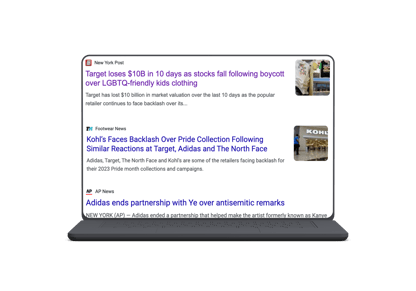The Vanishing Divide Between Public Affairs and Marketing - and What It Means for Your Ads

You have a job to do - legislation to influence, a company reputation to defend, and revenue to grow. But somewhere else in your organization, there’s a marketing department with goals of its own that seem to inch deeper into your territory with each passing day.
The distinctive roles of marketing and public affairs are fading. They are beginning to blur together.
This shift has been a long time coming. In serving both sides of the equation with issue-based microtargeting solutions for decades, Tunnl’s team has witnessed the narrowing chasm between marketing and public affairs, helping to keep both departments on the same page as they navigate new, value-based buying behaviors.
And it’s true: We bring our values and beliefs into our roles as consumers, employees, investors, shareholders, and leaders more than ever. They influence how we operate in every aspect of our lives, including purchasing decisions. Your marketing department sees an opportunity to appeal to the values influencing buyers, so they’ve been eyeing issue-based campaigns as an in.
-1.png?width=272&height=272&name=Blog%20article%20image%20(5)-1.png) But if your departments aren’t collaborating, you’re both at risk of ruining what you’re working on. Look at those other companies who are making headlines for all the wrong reasons after trying out issue-based advertising campaigns. Those instances are a direct result of departments with aligned goals - appealing to their constituency’s values - but lacking an aligned plan.
But if your departments aren’t collaborating, you’re both at risk of ruining what you’re working on. Look at those other companies who are making headlines for all the wrong reasons after trying out issue-based advertising campaigns. Those instances are a direct result of departments with aligned goals - appealing to their constituency’s values - but lacking an aligned plan.
You need to find an effective way to come together, but hold on. Before you can choose a solution that unifies your departments, you need to understand why public affairs and marketing are on a collision course and what it’s going to take for both disciplines to share the road ahead effectively.
What’s the Difference Between Public Affairs and Marketing?
Back in the day, the divide between public affairs and marketing departments was as clear as it was literal. Public affairs personnel would be out in Washington, D.C., engaging with policymakers on issues that directly affected their business from a regulatory perspective. Meanwhile, marketing teams would be headquartered in offices throughout the country, focused solely on selling the product, service, or experience that brought revenue in the door.
The two departments didn’t interact very much.
But now, failing to communicate across public affairs and marketing divisions could cost companies billions of dollars.
Why is the Divide Between Marketing and Public Affairs Disappearing?
What once was public affairs territory has become a marketing minefield. It’s blurring the lines between the two sectors. How?
 You may have noticed more and more companies speaking out on social issues. Their successes and failures make the news often; you can probably think of at least three instances of that off the top of your head right now.
You may have noticed more and more companies speaking out on social issues. Their successes and failures make the news often; you can probably think of at least three instances of that off the top of your head right now.
But you hear more about it when the company’s stance on an issue does not resonate with its audience. They alienate customers, earn the scorn of investors, and are forced to pick up the pieces under a very public spotlight.
So, why are so many organizations sticking their necks out about issues if the risk is so extreme?
Who is responsible for the shift in marketing and public affairs?
We know that shoppers prefer to buy from brands that share their values, creating a certain amount of increased hype around corporate social responsibility. Whether it’s diversity, equity, and inclusion that’s top of mind for buyers, or environmental, social, and governance issues, consumer awareness has increased, as have their expectations.
But it isn’t always consumers coaxing companies to assert their values on controversial social issues. In fact, Tunnl’s research into how the average American feels about companies making public environmental, social, and governance policies revealed that, so far, most of the country hasn’t made up their mind yet; that is, where a brand stands on social issues isn’t that important to most Americans right now.
So, if it’s not for the almighty buyer, who is convincing marketing departments to step into the realm of public affairs?
Marketing teams may be compelled to launch issue-based campaigns because they want to:
 Attract new customers outside their established demographic
Attract new customers outside their established demographic- Appease investors with public-facing stances
- React to legislative decisions or actions in their state of operation
- Support their employees subjected to legislation that conflicts with their values
Internal concerns - e.g. the things that keep investors and employees happy - are now public facing. CEOs are becoming the face and figurehead of their company’s values, for better or worse. Marketing is not always about a product or service anymore; it’s about your brand’s identity and values - wherever they may come from - even if that doesn’t end up improving revenue right away.
“It’s not about the values of the CEO; the CEO has to reflect the values of its employees and the way that company does business,” says Stephanie Cutter, Founding Partner at Precision and panelist for Tunnl’s A Data-Backed Discussion on the Future of ESG in America webinar.
“If that comes with not attracting a particular customer, that is a price that you have to pay, but again, think of that future customer - the Millennial or Gen Z. You’re probably in line with them. It’s not about this quarter. It’s not about the latest Twitter conversation. It’s about your long-term strength as a company.”
Every purpose-driven campaign a company runs will have consequences, good and bad. What sets a success from a failure is how well you know your audience and how accurate your cost-benefit analysis ends up being in the long term.
But without public affairs collaborating with marketing to nail the message and targeting, there’s going to be trouble now and later.
What’s at Stake if Marketing and Public Affairs are Not on the Same Page?
Before you start drafting an email about issue-based ad campaigns to your marketing department with “Please Stop” as the subject line, know this: silence isn’t really an option. Demand for clarity around company values is already out in the ecosystem, and your marketing department is probably already feeling the pressure or sensing an opportunity. They can’t be silent online any more than you can keep quiet in D.C.
 You cannot slow the tectonic collision of public affairs and marketing, but you can work together to control it within your organization. And you must.
You cannot slow the tectonic collision of public affairs and marketing, but you can work together to control it within your organization. And you must.
If marketing campaigns on a platform that’s inconsistent with the regulatory efforts of public affairs, you’ll be in hotter water than you can handle before you know it. Contradictory values torpedo reputations, cannibalize both departments’ budgets, and cost you customers.
Taking a stance is not the problem. The challenge is getting on the same page about what that stance will be and who it will serve.
“We believe that people - and therefore consumers, shareholders, investors - don’t care if you pick a side,” says Alex Schriver, Executive Vice President and Head of Public Affairs at Targeted Victory, while commenting on the esteemed reputations of Chick-fil-a and Patagonia during Tunnl’s webinar: A Data-Backed Discussion on the Future of ESG in America.
“They mind if you pick and choose sides based on the Twitter mob of the day.”
Fail to get on the same page, and you risk wasting resources and losing valuable support. But how do you seamlessly align two departments that, until recently, operated worlds apart?
How Can Public Affairs and Marketing Improve Collaboration?
Interdepartmental collaboration isn’t easy. Ask marketing about their relationship with sales, and they’ll tell you: “Working together” often means competing for resources when they should be collaborating or being at odds when they should be enabling each other.
These are the three steps you can take to avoid similar tension when you unite public affairs and marketing.
1. Share Insights
Each department will have its own ideas about how to best handle the task at hand. Sure, you all want to accomplish the same thing, but you all have different budgets, data, and skill sets to achieve it.
 Start seeing your collaboration as an advantage instead of a competition.
Start seeing your collaboration as an advantage instead of a competition.
Public affairs has valuable insight about the nuance of reputation management around sensitive issues and progressing an agenda. Marketing understands how to reach consumers, plus access to creatives that will build an evocative campaign.
By unifying your departments, you combine valuable data and can make a much stronger argument for increased funding to both respective departments. Public affairs could get more money to work with since their efforts are now linked to marketing and improving the bottom line of the business. Marketing could gain more leverage to create and publicize a concrete brand identity across the entire organization with public affairs on their side.
But there will be compromises.
“You have to look at it holistically,” advised Stephanie Cutter during A Data-Backed Discussion on the Future of ESG in America. “You have to look at all the audiences that you’re serving. You have to look at what is true to who you are as a company, and whether or not speaking out on something that really has nothing to do with how you do business and what is the cost-benefit of doing that.”
So, when you consider the bigger picture, who should your campaigns speak to, and what do they want to hear?
2. Establish Clear Goals and Values
You all may come to the table with your own goals, but there needs to be a consistent thread that tethers them all together. Defending and growing your company’s reputation in an increasingly value-based economy should unite you. Use that as a starting point to agree on an overall goal and a set of values the company can authentically represent.
“Authenticity is the key to this,” says Brent Seaborn, Tunnl’s Chief Data Science Officer. “You can’t fake it.”
Consider what you want to achieve for the company and what you want to be known for. You’ll need to consider every audience you serve, internal and external, when you draw up this value set.
3. Know Your Audience
The decision on which issues are worth speaking on, when and how to broach those issues, and who you need to reach with your message will have to be a symbiotic conclusion; it has to serve all of you, or otherwise, public affairs and marketing have to agree that the consequences will be worth it in the long run.
“You need to know about your customer base, and you need to know about your employee base and anyone else that matters to you before you engage on these issues,” says Seaborn. “Prioritize learning what motivates or persuades your target audience when it comes to these topics before you put dollars behind a campaign on the issue.”
Establishing a clear, shared understanding of who your target audience is, what they believe, and how they are influenced will give public affairs and marketing a common ground to campaign from.
But how do you figure all of that out? And how can you share that information seamlessly across departments and across advertising tools, even as sentiments shift?
Using Tunnl Audiences to Connect Your Public Affairs and Marketing Efforts
You know what can happen if public affairs and marketing operate in silos, and you’re prepared to bridge the gap to avoid any catastrophic miscommunications on full public display.
How you unite your departments for authentic, compelling campaigns is where the Tunnl Platform comes in.
We offer hundreds of prebuilt audiences based on hot-button issues in the regulatory space that can be instantly deployed in advertising campaigns across the entire digital, steaming, and linear TV ad ecosystem. Our premium prebuilt audiences like the U.S. policy, healthcare, tech, and finance Opinion Makers in the Premier Audience Suite give you direct access to the nation’s decision-makers as well.
But what really matters is that this audience data can be shared across your departments to maximize your campaign efficiency and ensure every advertiser and advocate in your organization is targeting the right audience at all times. Tunnl refreshes audiences every quarter so you know the sentiments reflected in the audience are genuine and updated across all major ad platforms and demand-side platforms for streamlined application to your campaigns.
“Tunnl has the prebuilt issue-based audiences that marketing needs to advertise to and that public affairs needs to influence,” says Adam McInturff, Tunnl’s Director, Business Development. “You’ll have access to hundreds of segments that both groups can engage. You’re not just collaborating internally; you’re speaking to the same people with a focused, cohesive message for all of your outward communications when you use Tunnl.”
Your potential magnifies exponentially when public affairs and marketing pool their influence around the same audiences and issues. Tunnl makes that possible, fast.


